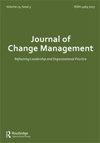在变革中采取战略行动:一种过程和居住的世界观方法
IF 3
Q2 MANAGEMENT
引用次数: 0
摘要
摘要战略变革过程具有高度的模糊性和不确定性。应对这些变化需要一种具有更广泛技能和应对机制的动态方法。在这篇文章中,我们主张广泛关注变革,考虑战略制定的隐性因素。我们采用了居住世界观和强大的过程本体论,并结合实践视角,以捕捉战略变革过程的复杂性和丰富性,重点关注身份和合法性动态。本文报道了一个新兴的过程模型,即非管理职位的个人如何应对和理解计划中的战略变革。这项研究采用了一种纵向的、过程性的方法,以南非商学院为研究背景。该研究的结果有助于加深对战略变革过程中发生的动态的理解,表明战略制定是一个涉及本能、调整和模仿行动的动态过程。了解个人在战略变革过程中的反应、适应和应对方式,有助于深入了解战略变革是如何实现或限制的,这可能会对未来如何设计或实施变革过程产生影响。MAD声明本文的目的是从非管理职位的个人角度,通过对不断发展的组织背景下的战略出现和变化进行动态和时间的描述,来有所作为(MAD)。我们采用了一种间接的方法来揭示身份和合法性“作为过程”的动态和微妙性质,认为这些结构是不稳定的,并且总是在“成为”,从而暴露了战略变革过程中的战略隐性因素。新兴的过程模型从居住世界的角度重新定义了机构、过程和实践如何相互关联。本文章由计算机程序翻译,如有差异,请以英文原文为准。
Acting Strategically During Change: A Process and Dwelling World-view Approach
ABSTRACT Strategic change processes are characterized by high levels of ambiguity and uncertainty. Responding to these changes requires a dynamic approach with a wider set of skills and coping mechanisms. In this article, we argue for a broad focus on change that considers the tacit elements of strategising. We adopted a dwelling worldview as well as a strong process ontology combined with a practice perspective to capture the complexity and richness of a strategic change process with a focus on identity and legitimacy dynamics. This article reports on an emerging process model of how individuals in non-managerial positions respond to and make sense of planned strategic change. The study followed a longitudinal, processual approach using a South African business school as the research setting. The findings of the study contribute towards a deepened understanding of the dynamics that occur within strategic change processes, showing that strategising is a dynamic process involving instinct, adjustment and phronetic action. Understanding how individuals respond, adapt and cope during strategic change processes provides potentially helpful insight into how strategic change is enabled or constrained, which could have future implications on how change processes are designed or implemented. MAD statement The intention of this article is to Make a Difference (MAD) by presenting a dynamic and temporal account of strategic emergence and change within an evolving organizational context, from the perspective of individuals in non-managerial positions. We adopted an oblique approach to uncover the dynamic and subtle nature of identity and legitimacy ‘as-process’, viewing these constructs as unstable and always in ‘becoming’ exposing the tacit elements of strategy during a strategic change process. The emerging process model reconceptualises how agency, process and practice interrelate within a dwelling world-view perspective.
求助全文
通过发布文献求助,成功后即可免费获取论文全文。
去求助
来源期刊

JOURNAL OF CHANGE MANAGEMENT
MANAGEMENT-
CiteScore
6.60
自引率
20.00%
发文量
14
期刊介绍:
Journal of Change Management is a multidisciplinary and international forum for critical, mainstream and alternative contributions - focusing as much on psychology, ethics, culture and behaviour as on structure and process. JCM is a platform for open and challenging dialogue and a thorough critique of established as well as alternative practices. JCM is aiming to provide all authors with a first decision within six weeks of submission.
 求助内容:
求助内容: 应助结果提醒方式:
应助结果提醒方式:


